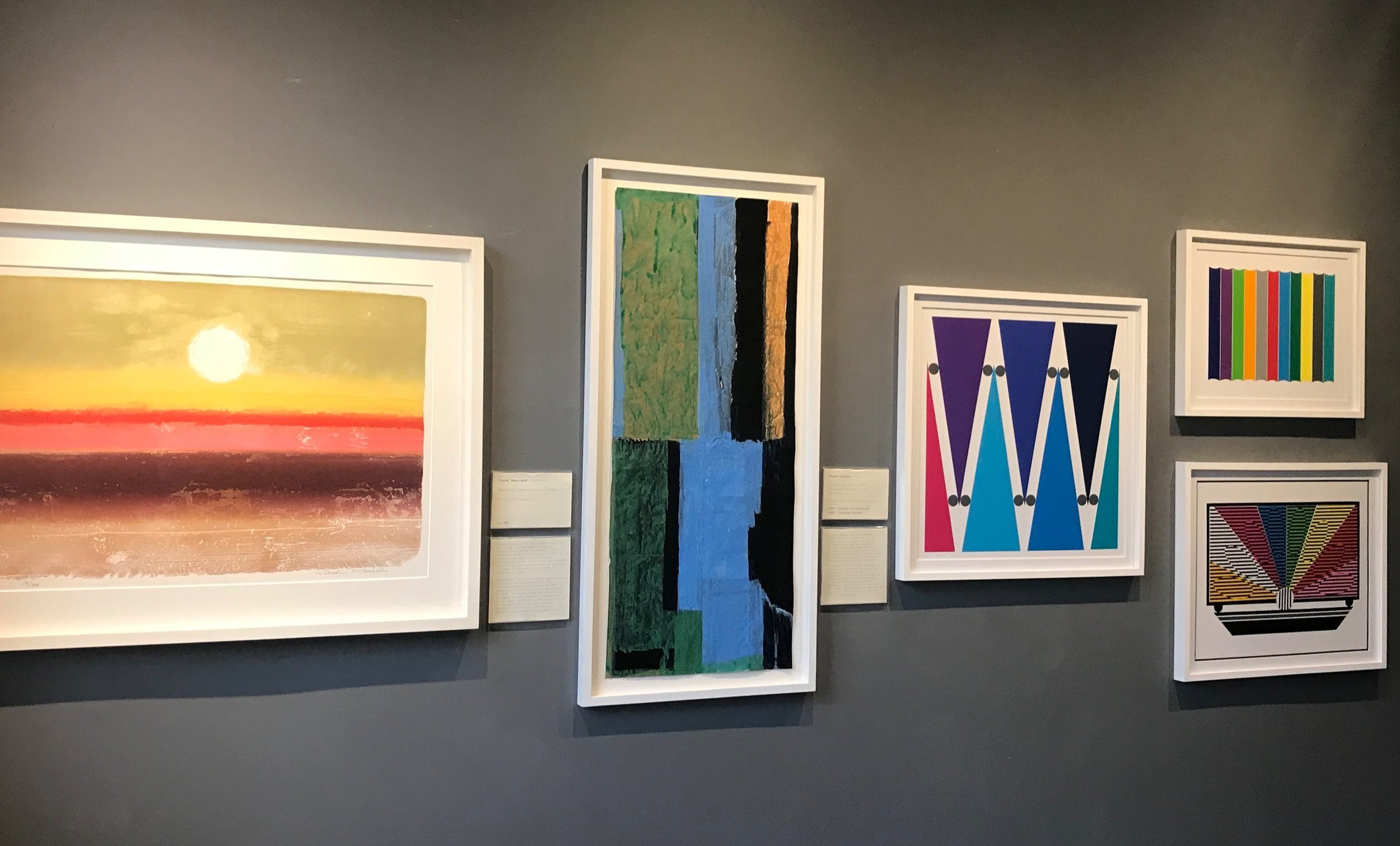Above: Liam Hanley (1933-2019) Beach Hut and Ice, c.1990.Oil on cotton laid on card. Framed size:H:33 x W:34.5cms. Unframed size:H:14 x W:15.5cms. Below: Christian Aldridge Summer,2022 Night Colours,2022. Oil and distemper on canvas.
John Northcote Nash CBE RA (1893-1977). The Stour at Bures, 1936. Lithograph on paper. (Contemporary Lithograph Series 1). John Nash (brother of Paul Nash) was a war artist in both World Wars and specialised in landscape painting. He visited East Anglia regularly and moved to Wormingfold in 1946. The Stour at Bures is a rare lithograph produced as a part of the first series of Contemporary Lithographs in 1937. They were printed in editions of 400 and most of the remaining stock of The Curwen Press were destroyed when it was bombed in 1940.SOLD.
Above:Hugh Verschoyle Cronyn (1905-1996). Coln Estuary, 1950. Oil on canvas laid on card. SOLD.
Lionel Victor Bulmer 1919-1992 Landscape with Walberswick Church Tower, c.1970. Oil on board
Christian Aldridge. Red Space, 2022. Oil on linen. Aldridge works from a studio near our gallery whilst also teaching at East Coast College, Lowestoft. He uses distemper as a ground on varying gauges of canvas and linen onto which colours are applied and soak into the medium. He also uses gesso as a ground where he scrapes back to create imagery and abstract shapes influenced by the landscape of East Anglia. This work is one of the largest works we have shown by Aldridge. SOLD.
Joyce Pallot (1912-2004) Mythical Landscape, 1960s. Watercolour on paper. Pallot studied at Colchester School of Arts and later studied Industrial Design at Southend School of Art. From 1948 she formed a dynamic partnership with her husband Henry Collins designing murals and exhibitions, including the Sea & Ships pavilion at The Festival of Britain in 1951. As in the concrete murals they later designed this large painting delights in the magical and fantastical elements of the sea and seashore.
John O Connor (1913-2004) Sea Edge, c.1960s. Lithograph on paper 1/1. O’Connor attended the Royal College of Art from 1934-7 where he was taught by Eric Ravilious and John Nash. After serving in the RAF he became the Principle of Colchester School of Art where his colleagues included John Nash and Edward Bawden. After exhibiting at the prestigious Zwemmer Gallery in the 1960s, his work was purchased by the Arts Council Collection, Tate & The British Museum. SOLD.
Mary Newcomb (1922-2008) Black Butterfly at Lanercost, 1990. Pencil on paper. After turning to farming at her farm in the Waveney Valley, Suffolk, Mary Newcomb observed the countryside around her, following her inspiration by John Constable’s attachment to the Stour Valley. She obsessively drew and painted en plein air capturing the transient moments in landscape as the Season’s change. She had her first solo show at Crane Kalman Gallery - who continue to represent her some 50 years later. There is an extensive inscription to verso (which we have framed to be visible) that describes the experience she felt when capturing this image.
Above: Frank Downton (1936- ) (L to R) Zig Zag and Dots, c.2015, Coloured Stripes,c.2015, Television, c.2015. Unique hand cut polyvinyl on acylate board. Downton worked for Chris Prater at Kelpra Studios, London in the mid 1960s, assisting artists such as Bridget Riley, Eduardo Paolozzi, Gillian Ayres and Sidney Nolan. He worked closely with Riley and Paolozzi at their request. Downton creates his own works using the exceptional skills he developed assisting artists at Kelpra married with his own vibrancy, spirit and love of colour. Each work is hand-cut, a unique work and is signed on the reverse.
Above centre: Frank Beanland (1936-2019) Abstract Composition, c.1990s. Acrylic on newsprint. Beanland studied at the Slade School of Art before moving to Cornwall in 1962 where he was associated with The Porthleven Group and adopting abstraction. He moved to Suffolk in 1966. His early paintings where he used a palette knife gave way to his acclaimed spot paintings from 1965 which introduced his broad spectrum of colour. This work is an example of his technique of using acrylic paints on newspaper which provided a low cost material and allowed greater risk taking and fluidity in his work which became more geommetric.
Michael Rothenstein (1908-1993) Sunrise at 36,000 Feet, 1973. Coloured Woodcut and linocut on paper. Edition 10/90.















